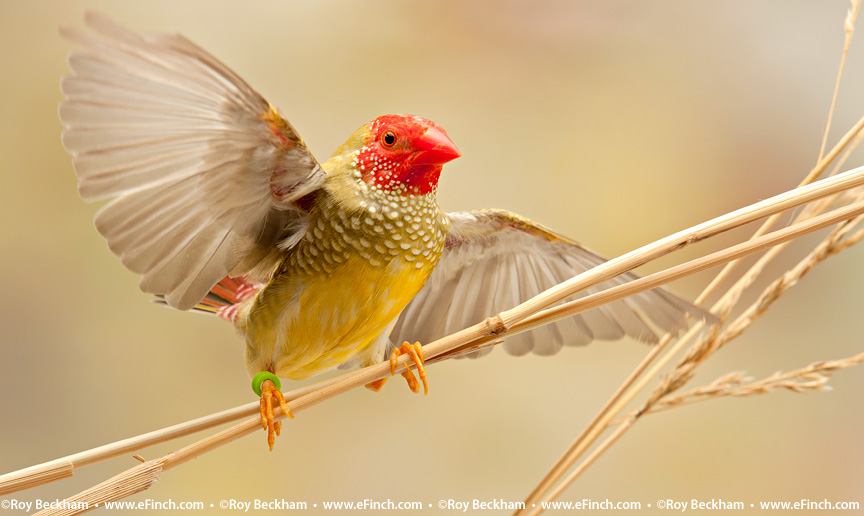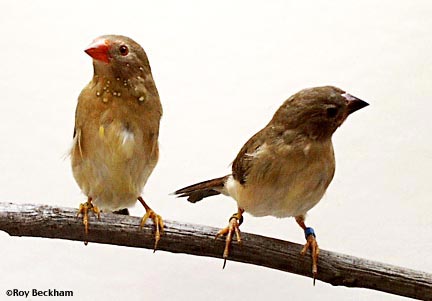




 |
|
|||||||||||||||||||||
 |
|
|
|
|
|
|
|
|
|
|||||||||||||
|
|
|
|
|
|
||||||||||||||||||
|
|
|
|
|
|
|
|
|
|
||||||||||||||
|
|
|
|
|
|
||||||||||||||||||
|
|
|
|
|
|
|
|
|
|
||||||||||||||
|
|
|
|
|
|
||||||||||||||||||
|
|
|
|
|
|
|
 |
|
|||||||||||||||
 |
 |
|
||||||||||||||||||||
|
|
|
|
||||||||||||||||||||
|
|
|
|
|
|
|
|
|
|
|
|
|
|
|
|
|
|
|
|
|
|
|
|
| Star Finch - Neochmia ruficauda | ||||
| Star Finch pair | ||||
|
Common Names Description Diet
Breeder's Notes The parents will do very well on the standard diet noted above. They will take a bit more egg food during the brooding period. Many sources list that live food is necessary. I don't think mine even know what it is. All their needs can be met with the egg food. The young are weaned at about 14-21 days. They seem to take a little longer than some other Australian species and it's best to wait until you're sure they are on their own. Even when fostered under Society finches they are slow to wean. The young fledge a dusky green with a buff belly. The tail has a hint of the red (rufous) tail that the adults have. The beak is black and they do not have the red or spots of the adults. They take quite a while to molt into adult plumage. Similar to the length that juvenile Gouldians take, approximately 4-6 months. I have read that there is an intermediate or sub-adult plumage that the juvenile molts into before showing final adult colors. I have not noticed this, or they are slowly molting the entire time until they are fully molted into their adult colors. Young males will begin singing while they are still in juvenile plumage, plus any young that show red feathers appearing below the chin can be identified as males. Star finches are easily fostered under Society finches. The appearance of the young, the begging patterns, and brooding period are all similar to Society finches. By using the Society finches as back ups to your breeding Stars or ones that are not reliable in your environment, you can quickly establish a breeding strain of your own. With the Star finches being such shy incubators, I had trouble getting them to settle down in my birdroom. I expect that that will not be an issue with the birds that I have raised from those original birds. These young are used to my foods, my birdroom and me.
There are several mutations of the Star finch available. The Yellow face is the most popular and prevalent. There is also a pied, fawn, cinnamon, Isabel and blue mutation. The pied is not as dramatic as many pied mutations, only causing a ring of white around the mask and white wing primaries and tail feathers. The fawn and cinnamon are similar, from what I understand, with varying shades of brown. This may actually be the same mutation, but is being called by the two names. If it is a "brown" mutation of the Star, it would probably be more appropriate to call the mutation cinnamon since the Star is a yellow based bird. The Isabel appears to be a form of dilute. Reducing both the green and yellow colors of the body, but not the red. The blue mutation is not as dramatic as the blue mutation of Gouldian finches, but it does eliminate the yellow base from the coloring leaving the belly white and the back a dark shade of blue. I have only heard of this mutation being reported, but have not seen pictures of it or know if it as been established since those earlier reports. When I was holding some Melba finches, I was warned not to keep them with any of my Star finches due to their red face. The Melba males were aggressive birds that would attack other birds that it thought threatened its pairing with its mate. The Melbas have red faces as well. |

Star Finch male

Immature Star finches - 10 weeks (left), 7 weeks (right). See the mouth markings of nestling Stars
